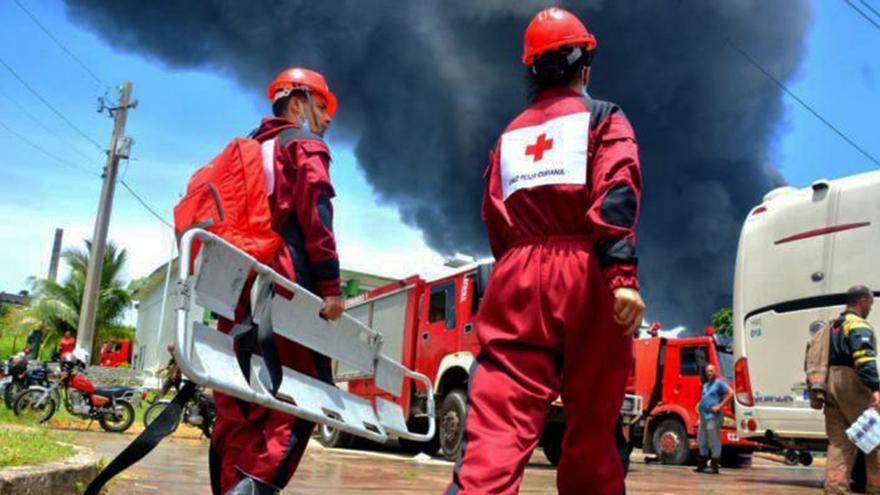
![]() 14ymedio, Havana, 7 August 2022 — “A failure in the lightning rod system, which couldn’t withstand the power of the electric shock,” is the official version that the Cuban Government has given so far on the cause of the gigantic fire that began at the Matanzas Supertanker Base on August 5.
14ymedio, Havana, 7 August 2022 — “A failure in the lightning rod system, which couldn’t withstand the power of the electric shock,” is the official version that the Cuban Government has given so far on the cause of the gigantic fire that began at the Matanzas Supertanker Base on August 5.
The official version that has added another element this Saturday was unconvincing. “The First Secretary considered that the fire system apparently failed, something previously recommended,” the State newspaper Granma published. “This issue needs to be reviewed to avoid similar events in the future, especially in thermoelectric plants and fuel facilities,” it added.
Faced with questions as to whether the lightning rod system was certified by the Fire Protection Agency (AFP), the official argument focused on pointing out that “the energy of lightning can be very destructive, as it clearly was in this case.”
Danger Ricardo, a 37-year-old welder who works there, contacted by the AFP agency, said that there is no explanation for how the tank’s lightning rod system failed. Videos regarding the fire began to be shared on social networks, including a graphic uploaded to the Twitter account of an Internet user, who identifies herself as Yanetsis, about security protocols at the time of a fire.
The healthcare emergency technician based in Spain, Joaquín Alberto Reyes Franc, indicated that with this type of accident you need to “cool the affected tank. Large volumes of water and huge amounts of foam are needed.”
Reyes Franc explained that this represents “an advanced technique of attack and patience” and recalled that “in Spain we have suffered at least three accidents of this type, and it was very hard work. Especially the Escombreras fire in 1969 (8 days of combat).”
The accident, which according to official reports has so far caused the death of firefighter Juan Carlos Santana Garrido and injuries to 122 people, of whom 24 are hospitalized. But the regime still doesn’t offer details about 16 people who were fighting the flames and were close to a second tank in the complex that exploded.
At seven o’clock at night on August 5, lightning struck tank 52, which at that time was at 50% of its capacity, which is 50,000 cubic meters. “The most important thing is to maintain strict control of the temperature” of the damaged tank, rescue teams explained to the official newspaper, Girón.
The “strict temperature” control was carried out through water discharges. This has been the main way to try to control and put out the fire. A day after the catastrophe, on August 6, Prime Minister Manuel Marrero Cruz highlighted the “feat” of the firefighters and reiterated the strategy to confront the accident, while moving away from the fire.
“We are now leaving the site of the fire in Matanzas. The fuel tank remains, and the nearest tank is being cooled with water, which reduces the possibility of the fire spreading,” Marrero shared through his Twitter account. In addition, the discharge of water from a helicopter over flames that soon reached a second tank was observed.
In support of Cuba, this Sunday, 60 rescue soldiers and 16 technicians from Petróleos Mexicanos (Pemex) arrived from Mexico with equipment and chemicals, while 35 firefighters, specialists and technicians from Petróleos de Venezuela arrived with 20 tons of foam and other chemicals.
“We’re here to help prevent risks and put out the fire with water and foam,” said Brigadier General Juan Bravo, the head of the Mexican expedition.
Translated by Regina Anavy
____________
COLLABORATE WITH OUR WORK: The 14ymedio team is committed to practicing serious journalism that reflects Cuba’s reality in all its depth. Thank you for joining us on this long journey. We invite you to continue supporting us by becoming a member of 14ymedio now. Together we can continue transforming journalism in Cuba.
